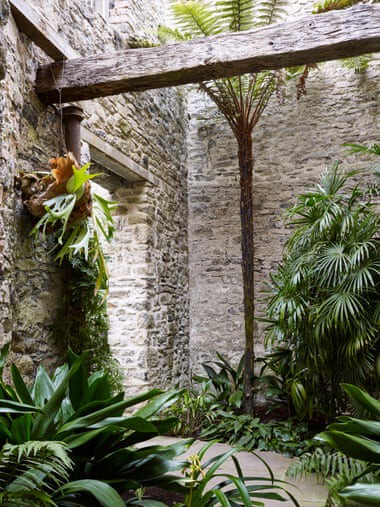Under its glass roof, this stunning Welsh garden is an inspiration for locked down growers
Aberglasney in south-west Wales is one of Britain’s finest heritage gardens. Saved from dereliction in 1995, the elegantly remodelled cloister and three gardens (kitchen, woodland and shrub) surrounding its restored 15th-century mansion are testament to a vibrant, open-minded horticultural approach that has kept me coming back for a decade.
But more recently, my attention has turned to Aberglasney’s hidden gem: an unconventional indoor garden, part of the house itself, called the Ninfarium. It consists of two storeys of ruined walls in the oldest part of the building, topped with a modern glass roof. The exposed walls and window cavities are overgrown with exotic greenery; ginger and voodoo lilies spring through a doorway; Spanish moss drips from the mortar; and hefty bananas stretch to the roof, all concealed Narnia-like behind a heavy oak door. The head gardener and Aberglasney director, Joseph Atkin, adds plants almost weekly. “It’s a constantly evolving space,” he says.

For the majority of us still relatively housebound by Covid-19 – particularly those without gardens – houseplants have become a lifeline to the natural world. And the Ninfarium, whose growing conditions are more like a regular home than a tropical greenhouse (thanks to its thick stone walls, temperatures rarely fall below 8C or exceed 30C), offers no end of inspiration.
Navigating the Ninfarium’s paths, I meet both familiar and unexpected plants, many of which would translate well into ordinary household pots: glossy aspidistras, climbing asparagus vines and peace lilies, half-hardy mahonias, scrambling begonias and the African parrot impatiens, I. niamniamensis. “All of these plants have been through a long trial-and-error process to see how they perform,” Atkin tells me. The spotted cane begonia, B. ‘Snowcap’, certainly appears at home, its sleek leaves bright with reflected light. A lush thatch of Crinum jagus was salvaged last minute from a decommissioned glasshouse at Liverpool’s Botanic Gardens. “I got a phone call one afternoon to say that they were renovating and plants were going spare. By 4am I was driving there in a van with one of our students. We packed it so full the student had to return on the train.” Ferns thrive here, too; asplenium, davallia, elkhorn and maidenhairs all take advantage of the cool, semi-shaded environment.
Orchids, however, Atkin treats as an exception. “There’s a trick to growing them,” he says. “Indoor moth orchids – the common supermarket variety – are epiphytic: they grow on trees. So attach them with wire to a piece of timber, and just water the wood. They prefer this to a pot; the timber holds moisture yet it’s impossible to overwater.”

Inspiration for the Ninfarium can be traced to its horticultural namesake, the Garden of Ninfa, just south of Rome. An ancient and once prosperous town sacked and left to ruin during the late 14th century, Ninfa was gradually reclaimed by nature and, years later, sensitively planted with flowering shrubs by the English gardener Ada Bootle-Wilbraham; a similar sense of nature returning enlivens Aberglasney’s Ninfarium.
Of course, for this part of the house to be planted up, the walls had to be fortified. Atkin points to the place where a steel girder supports the glass structure above. “This style of conservation, known as ‘capping’, was rare when this was first installed [in 2005] – where a derelict building is covered to protect it from the elements, but mostly left as it is.” When rain clatters on the glass, the sense of enclosure is wonderful.
There’s no shortage of rain in Carmarthenshire; it’s what makes Aberglasney’s borders so virile. Nonetheless, having somewhere to escape to adds greatly to the visitor experience. There are plans to further develop the Ninfarium, and Atkin has a long list of exciting ideas. “There’s potential to add an elevated walkway, and I’m looking at constructions for hanging planters – floating balls of moss and timber. I want to challenge the notion that plants must be attached to the floor.”
No doubt creative approaches to indoor gardening will increase as our obsession with them grows, but there’s something particularly captivating about Aberglasney’s garden-behind-doors, which celebrates ruin alongside regeneration.